Prisons
where Fenians languished
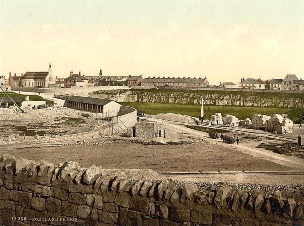 Portland
Prison, Dorset, England
Portland
Prison, Dorset, England
Portland's prison opened in 1848 for the holding
of adult convicts. The purpose of a prison at
Portland was largely to make use of convict
labor in the construction of the breakwaters
of Portland Harbor and its various
defenses. The
Admiralty Quarries were developed for
convicts to work in and once established,
convict labor was providing 10,000 tons of stone
per week for use on the breakwaters. The
conditions within both the prison and its
quarries throughout the 19th-century would later
help calls for penal reform in the UK, as many
prisoners died while quarrying stone.
Fenian, Thomas J.
Clarke described his treatment there as follows:
we treason felony prisoners were known as…
the ‘special men,’… kept, not in ordinary prison
halls but in penal cells- kept there so that we
could be more conveniently persecuted, for the
authorities aimed at making life unbearable for
us. The ordinary rules regulating the treatment
of prisoners, which, to some extent, shield them
form foul play and the caprice of petty
officers, these rules as far as they did that,
were in our case set aside… This was a
scientific system of perpetual and persistent
harassing… harassing morning, noon and night,
and on through the night, harassing always and
at all times, harassing with bread and water
punishments, and other punishments with ‘no
sleep’ torture and other tortures. This system
was applied to the Irish prisoners and, to them
only, and was specially designed to destroy us
mentally or physically – to kill or drive
insane.
Other Fenians
imprisoned there included,
Jerimiah O'Donovan Rossa,
John Daly,
Michael Davitt, William Francis Roantree and
John Devoy. Many other Fenian prisoners
spent time there as they were rotated to others
prisons on a regular basis.
Ballymullen Barracks,
Tralee. C0. Kerry
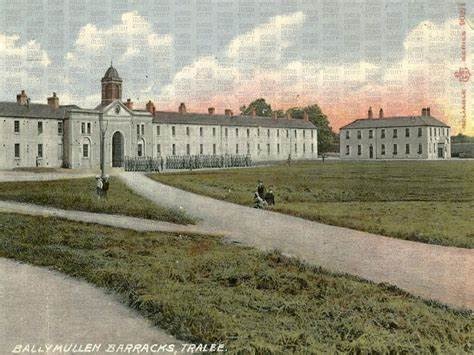 Ballymullen
Barracks were built between 1810 and 1815 for local militia
units. In 1881 the barracks were occupied by the Royal
Munster Fusiliers.
Ballymullen
Barracks were built between 1810 and 1815 for local militia
units. In 1881 the barracks were occupied by the Royal
Munster Fusiliers.
After the signing of the British-drafted Anglo-Irish Treaty
in December of 1921 the barracks were occupied by the Irish
Republican Army. In August of 1922, during the Treaty War,
British-backed Free State forces captured the barracks.
In the ensuing months the barracks were used to house
anti-Treaty Republican prisoners including
Tadhg
Brosnan.
For the duration of the war behind the barrack walls
torture, summary executions, sanctioned by leaders of the
Free State including Cosgrave, Mulcahy and Higgins and
carried out by their henchmen, was the order of the day.
At midnight on March 6th 1923, it was from these barracks
that nine prisoners were brought to Ballyseedy Wood near
Ballyseedy cross by soldiers of the Free State army. They
were Pat Buckley, John Daly, Pat Hartnett, Michael
O'Connell, John O'Connor, George O'Shea, Tim Tuomey, James
Walsh and Steven Fuller. When they got there, they were
tied around a log and a land mine was detonated. Most of
them survived the initial blast however, the soldiers used
machine guns and grenades to finish them off. All of them
died except Steven Fuller who was blown away by the force of
the blast. He landed in the nearby river Lee from where he
crawled for about 500 yards to Currans House. They took him
in and hid him in a dugout at the back of their farm for
some weeks. He was the only one who survived the massacre
Fremanthe Prison, Western Australia
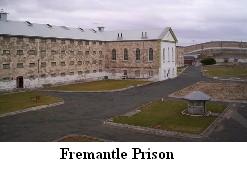 The construction of
Fremantle Prison, which began in 1851, was completed in
1859. Convict labor from the first convict ship, the
Scindian, to arrive at the Swan River Colony (renamed
Western Australia in 1832), was used to build the prison
from limestone-quarried onsite.
The construction of
Fremantle Prison, which began in 1851, was completed in
1859. Convict labor from the first convict ship, the
Scindian, to arrive at the Swan River Colony (renamed
Western Australia in 1832), was used to build the prison
from limestone-quarried onsite.
The last ship to
transport convicts to the prison was the Hougoumont. In
addition to the 218 convicts on board
62 Fenian
prisoners convicted for their involvement in the Fenian
Movement of the 1860’s were also on board.
Seven of
those Fenians, who took the
Fenian oath while serving in the British army were classified as "military
prisoners" by the British and treated as common criminals. The others 55,
who were classified as political prisoners were all released by
1871 providing that they did not return to Ireland. Of the seven
"military prisoners"
John Boyle
O'Reilly escaped in 1869 and the
other six aboard the
Catalpa
in 1876.
From 1850 to 1868 forty
three voyages were made from England to Fremantle carrying
more than nine thousand prisoners.
Fort Westmoreland (renamed Fort Mitchel in 1938) on
Spike Island in cork Harbor.
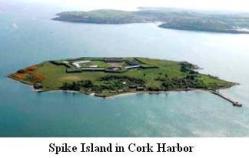 Spike Island is a small island
in Cork Harbor first settled in early Christian times.
Spike Island is a small island
in Cork Harbor first settled in early Christian times.
Due to its defensive location
in the harbor it was acquired by the British army in 1779
and Fort Westmoreland was built there to prevent French
attack on the trading port of Cork.
Later a prison and convict
depot, it was used to house "convicts" prior to penal
transportation. It gained a reputation as "Ireland's
Alcatraz". In
1848,
John Mitchel, Thomas
Francis Meagher and other Young Irelanders spent time on the
island en route to exile in Van Diemen's Land .
It remained in use as a
garrison and prison through the Irish War of Independence,
when IRA prisoners were held there. One of the prisoners
Richard "Dick"
Barrett was a prominent Irish Republican Army volunteer who
fought in the War of Independence.
During the
subsequent Civil War, Barrett along with three
other Republican leaders, Rory O'Connor,
Liam Mellows and Joe McKelvey were executed by the Irish Free
State in revenge for the killing of TD Sean
Hales. The extrajudicial executions were ordered
by the justice minister, Kevin O' Higgins.
Following the Anglo-Irish
Treaty, the island remained as one of the Treaty Ports, and
was only handed back to the Free State in 1938. The island
remained the site of a prison and military base for
some time.
In the early 1980s it was used as a correctional facility
for youth, notoriously in 1985 it became inmates mutinied
and briefly controlled the area; one of the accommodation
blocks was burnt. This facility closed in 2004
Kilmainham Jail,
Dublin.
 The jail that was built in 1796 was the last stop
for many of
Ireland's
freedom fighters
before their
gruesome
executions by
servants of the
British crown.
The jail that was built in 1796 was the last stop
for many of
Ireland's
freedom fighters
before their
gruesome
executions by
servants of the
British crown.
Each rising in
Irish history
typically would
contribute its
leaders to the
ranks at
Kilmainham. From
the United
Irishmen of 1798, to the
Young Irelanders
of 1848, to the
Fenians of 1867,
the jail was a
horrific and,
oftentimes, the
final
destination for
many of
Ireland's
heroes. One of the
most important
event in the
prison's history
was after the
Easter Rising of
1916, when
fifteen of the
leaders were
executed by
firing squad in
the
stone-breaker's
yard.
The jail
was
decommissioned
as a prison by
the Irish Free
State in 1924 as
its potential
function as a
location of
national memory
would be
complicated by
the fact that
the first four
of the 81
republican
prisoners executed
by the British
supported Free
State forces
during the Civil
War took place in
the prison yard
and that over
300 women were
imprisoned there
during the same
period.
The preservation
of the jail as a
museum and
memorial to the
1916 Easter
Risings was
originally
proposed by the National Graves Association
Click here for some of Kilmainham's
Jail most notable prisoners
Woking Prison
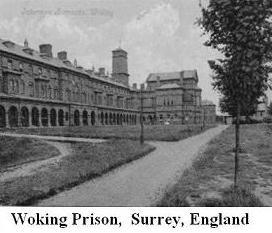 The Woking Invalid Convict
Prison - the first of its kind in the country - was begun in
1858 on almost 65 acres of land between Knaphill and St
Johns. In 1867 work started on a second prison on the site -
for female prisoners. It was while this was being built that
the male prison housed two Irish Fenians - Brian Dillon and
John Lynch - Lynch actually dying here in 1869.
The Woking Invalid Convict
Prison - the first of its kind in the country - was begun in
1858 on almost 65 acres of land between Knaphill and St
Johns. In 1867 work started on a second prison on the site -
for female prisoners. It was while this was being built that
the male prison housed two Irish Fenians - Brian Dillon and
John Lynch - Lynch actually dying here in 1869.
John Lynch was a
widower and publican who lodged in Cork City and became
involved with the Cork City
Fenians. He was
convicted on the word of an informer, John Warner, who
stated that Lynch was a colonel in the Fenian organisation
in Cork. Lynch was convicted of treason and felony by Judge
Keogh in December 1865. Overall the evidence used to convict
Lynch was rather weak for the sentence of 10 years penal
servitude.
Lynch was sent first
to Pentonville Prison. Later in December 1865, due to a
chest infection, he was moved to the hospital in Woking
Prison. Other inmates at Woking included
Jeremiah O'Donovan Rossa,
Captain Richard O'Sullivan Burke
(retired from the US army), Brian Dillon (a law
clerk from Cork), and Charles Kickham (author of the popular
novel Knocknagow).
Lewes Prison,
East Sussex, England
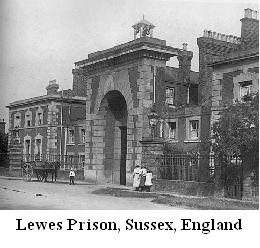 Lewes Prison
was built in 1853. Amongst the first prisoners housed there
were three hundred Finnish Grenadiers captured while
defending Bomarsund Fortress on the Åland Islands during the
Crimean War.
Lewes Prison
was built in 1853. Amongst the first prisoners housed there
were three hundred Finnish Grenadiers captured while
defending Bomarsund Fortress on the Åland Islands during the
Crimean War.
In the aftermath of the 1916 Easter Rising in Dublin as many
as 120 IRA prisoners were held there. Some of the better
known amongst these prisoners were Thomas Ashe, Diarmuid
Lynch, Frank Lawless, Harry Boland, Eamon de Valera and
Pıaras Béaslaí
.
The jail that was built in 1796 was the last stop
for many of
Ireland's
freedom fighters
before their
gruesome
executions by
servants of the
British crown.


 Ballymullen
Barracks were built between 1810 and 1815 for local militia
units. In 1881 the barracks were occupied by the Royal
Munster Fusiliers.
Ballymullen
Barracks were built between 1810 and 1815 for local militia
units. In 1881 the barracks were occupied by the Royal
Munster Fusiliers.  The construction of
Fremantle Prison, which began in 1851, was completed in
1859. Convict labor from the first convict ship, the
Scindian, to arrive at the Swan River Colony (renamed
Western Australia in 1832), was used to build the prison
from limestone-quarried onsite.
The construction of
Fremantle Prison, which began in 1851, was completed in
1859. Convict labor from the first convict ship, the
Scindian, to arrive at the Swan River Colony (renamed
Western Australia in 1832), was used to build the prison
from limestone-quarried onsite. 